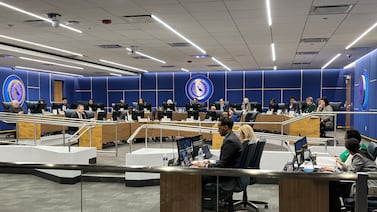Anna Spencer is about to begin her first full year teaching middle school math in September, starting her career just as Philadelphia invests tens of millions of dollars in brand new curricular materials.
She was one of 450 teachers who gave up two hours of their summer for a voluntary training on the new math resources. District officials say the $20 million curriculum from Imagine Learning will promote deeper understanding by students, instead of merely emphasizing process and procedure. And Spencer left the training energized.
“Students will be learning through problem solving rather than being told what to do,” she said.
The Philadelphia school district is planning to spend $70 million of pandemic aid on new textbooks, lesson materials, and other instructional resources that will start rolling out next school year, beginning with math. But how well teachers will be prepared to use them, and the impact they will have on classrooms, are issues still up for debate.
At its May meeting, in addition to the $20 million for Imagine Learning, the Board of Education voted to spend $20 million for an English language arts program called StudySync from McGraw Hill. The board also approved $5 million on new materials for English language learners and $5 million for new special education materials (A resolution to spend up to $20 million on science materials was withdrawn but is expected to be taken up later, bringing the total potential expenditure to $70 million.)
Anyone at the meeting hoping to learn more about the new instructional materials would have left disappointed, however. No district official gave any presentation about the new resources. And no board members asked questions about the resources before voting to approve them. The process underscored ongoing concerns about the district’s transparency.
In a letter to families and a subsequent press release, Superintendent Tony Watlington called the spending on new curricular materials a “historic investment” in the city’s children.
But some teacher preparation experts questioned whether there will be adequate professional development or teacher training to help new teachers and veterans get up to speed. (The English language arts materials will be phased in for the 2024-25 school year.)
“It’s really essential that the investment in teacher learning is deep” and involves something more than an optional webinar or a two-hour workshop, said Patrick Sexton, executive director of teacher education programs at the University of Pennsylvania Graduate School of Education. Many of Penn’s graduates go on to teach in Philadelphia schools.
The district invited feedback about updating curriculum during March and April and received some 3,000 responses, according to district spokesperson Marissa Orbanek. But that hasn’t stopped questions about the curriculum’s suitability, and whether teachers will be limited in their ability to help students in the same class who are at different levels of proficiency.
Nyshawana Francis-Thompson, the school district’s chief of curriculum and instruction, told Chalkbeat that the new materials represent “a significant shift from what we were doing in the past” and “will require a significant change for our teachers,”
“This is not an approach where the teacher stands in front of the classroom and … says ‘do step one, step two, step three,’” she said.
While district leaders worked with teachers and others to create an updated “academic framework” in core subjects in 2020, it hasn’t bought new materials since 2016, Francis-Thompson said. That framework lays out expectations for each grade level and lays out best practices.
More continuity for Philadelphia students across grades
Since 2016, in many subject areas, schools were able to choose between two or more different sets of curriculum resources. But now, through Watlington’s strategic plan known as Accelerate Philly, district officials are hoping to achieve more instructional continuity.
For all grade levels, “there will be one resource across the board,” Francis-Thompson said.
However helpful the voluntary professional development sessions are for teachers like Spencer who participated in them over two weeks in July, the 450 teachers who took part in them represent just a fraction of those who will be teaching with the new materials.
Officials stressed that such sessions are not the sum total of training and support that will be offered.
Sexton, from Penn, said that he considered the district’s initial voluntary training “a good first step,” and agreed that Imagine Math is “aligned with what we teach our [teachers-in-training] to do,”which is “going for deeper understanding. It’s looking not just for answers, but the thinking behind the answers,” he said. He also said the “culturally responsive” component of the math materials will help build support with parents.
Still, he said, it is important to consider “how are we looking at veteran teachers as learners, not as just implementers of curriculum,” Sexton said.
That’s where teachers like Eileen Wager come in. She’s been teaching for 13 years and is the “math lead” at Duckrey Elementary School in North Philadelphia. As such, she will be responsible for ongoing training for teachers at her school with the new materials.
She agreed with district officials that the new curriculum materials are focused on the students rather than the teacher. She noted a big change involves dividing students into groups so they can collaborate on problem-solving. In that model, the teacher works with one group while the others work independently.
Many teachers use this strategy now, but not all teachers are at ease with it, she said, even though “we’ve learned that having students split into small groups for hands-on activities is effective. I’m hoping this curriculum will be helpful in the long run in getting teachers comfortable with that.”
“Our math scores, as a country and as a district, have been in the toilet for years,” Wager added. “What we’ve been doing hasn’t worked. We need to be open to this new thing.”
According to the latest Philadelphia “district scorecard,” only 17% of students met the math proficiency standard on state testing in 2021-22, down from 22% in 2018-19.
Helping students reach a deeper understanding
Spencer, who will be teaching seventh grade at Bregy Elementary School in Southwest Philadelphia, said the two-hour training was helpful. Like Wager, she supports the use of small groups as part of the new math curriculum.
“I think it will be really really beneficial for students to have meaningful, deep understanding of content, versus rote memory or mimicking what the teacher is doing,” she said.
At the training session, teachers reflected on their own math experiences, discussed what they want their students to remember, and talked about the new curriculum’s philosophy and goals. Then they got a look at the new materials.
Spencer had two main questions during the training. Would the curriculum limit teachers’ agency by offering a daily script or rigid timeline? And what resources would it provide for working in a classroom where many of the students might be grade levels behind in their skills?
Ultimately, Spencer said the training convinced her that she could “switch things up if I need to.” She also said she thought the curriculum was nimble enough to allow her to help students who need additional help.
“The curriculum gives a list of prerequisites for each lesson,” she said. “We can see what students are supposed to have mastered [and can] review skills they’ve missed.”
Lola Sergeant, a five-year teaching veteran at Mayfair Elementary School who will teach seventh grade this fall, noted that the district’s academic framework calls for a more “conceptual” approach to math to deepen student understanding.
She said that dealing with students who are at vastly different levels “is an ongoing challenge,” but added: “I think this curriculum will do a better job of it, because it’s embedded more differentiation.”
Annemarie Hindman, a professor of early childhood education and educational psychology at Temple University, said the district’s emphasis on continuity through the new materials is an admirable goal.
But in practice, she said, teachers and school leaders are going to need a lot of support and buy-in to put these materials to work for their students, especially any changes to the reading materials.
“There is no curriculum package, no matter how scripted, that can help you work with every individual kid,” Hindman said.
Francis-Thompson said she understands these concerns, and said the district must ensure there’s “ongoing professional learning,” coaching, and other strategies in the coming years.
Spencer, for her part, is optimistic the new materials will be a boon for her as a new teacher.
“I trust what they’re trying to do,” Spencer said. “It’s a good starting point for me.”
Dale Mezzacappa is a senior writer for Chalkbeat Philadelphia, where she covers K-12 schools and early childhood education in Philadelphia. Contact Dale at dmezzacappa@chalkbeat.org.
Carly Sitrin is the bureau chief for Chalkbeat Philadelphia. Contact Carly at csitrin@chalkbeat.org.






